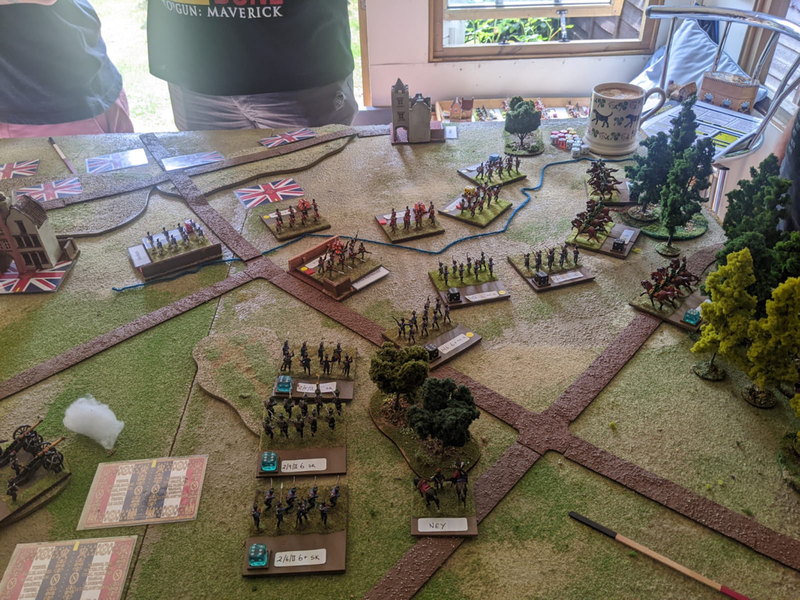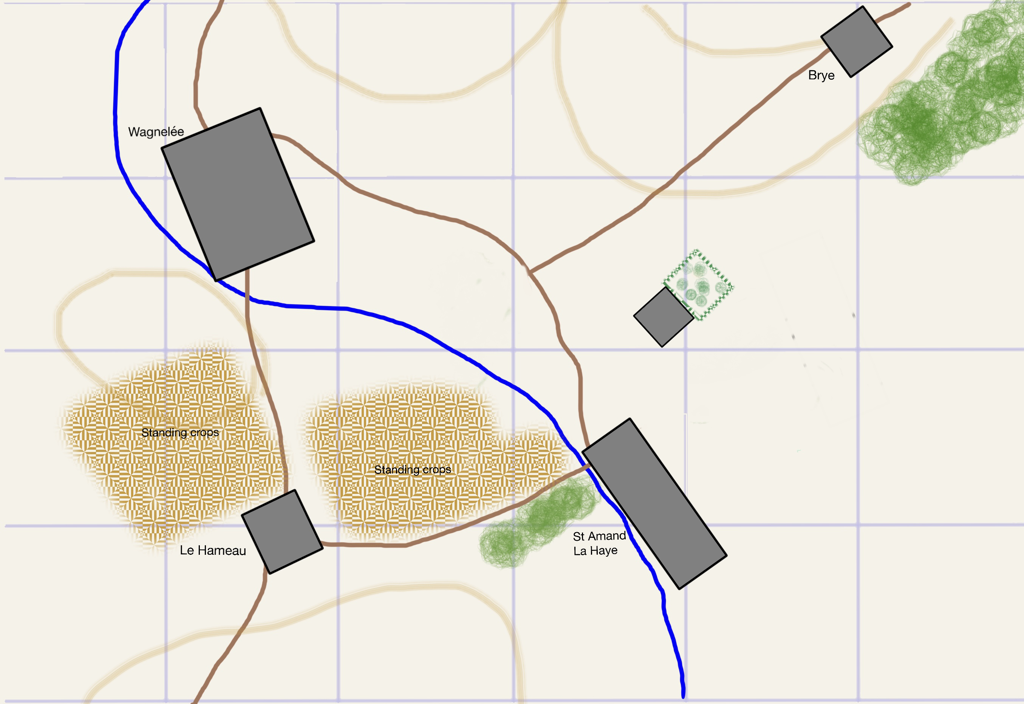|
Last month, I hosted a game of Blücher in the shed for Nick, Harry, Dan, James and Jack. The scenario was Abensberg, 1809, on the Scenarios for Blücher page. We have played a few games based on the 1809 campaign using Blücher, Lasalle and Soldiers of Napoleon, but I haven’t tried to game Abensberg until now. The reason, I suppose, is that the day was more a series of separate actions than a set-piece battle. Formations appeared on the scene from different directions and it was hard to coordinate movements in the heavily wooded and hilly Bavarian landscape. The game saw Jack and James’ Bavarians put early pressure on the Austrian right flank under Nick and centre under Dan. Nick and Dan had weak forces and several dummy unit cards, the threat of which slowed the Bavarians somewhat but of course were removed as soon as the enemy got within spotting distance. The French then appeared behind the Austrian right flank, though curiously, they advanced with some caution. Meanwhile Dan was shifting his Austrian forces from the centre to the right, as Harry’s reinforcements arrived on the left and he finally got moving. Poor Harry had spent much of the game watching Dan and Nick play, but he didn’t complain and declared himself happy to be moving his grenadiers and kürassiers. Athough slow, the French advance threatened to encircle Nick’s remaining troops and he withdrew his paper-thin units towards Dan. As the Austrian right folded backwards, Harry on the left began to swing around the Bavarian right, and so the front rotated steadily clockwise. For a time, the Austrians looked as if they were going to lose too many units but Franco-Bavarian losses mounted too and as the gaming day drew to a close, it was clear that Austria had done enough to thwart Napoleon’s ambitions for the day. The two French objectives were still comfortably in Austrian control and more Austrian reinforcements had arrived on table. Victory, albeit marginal, went to the Kaiserlicks. The game moved at a good pace and the players had no difficulties with the Blücher rules. One personal innovation I think worked well was to give each player two tokens at the start of the game that they could spend, either in combat or in rallying a damaged unit. We found when we played Waterloo last year that the ability to rally troops in the rules as written was too generous, meaning that a commander capable or rallying units dashed around restoring fighting power left right and centre: not realistic. On the other hand I like players to have choices they can exercise on how they influence the game. The two tokens meant intervention could be significant but did not dominate.
Overall, I think the battle went well and I enjoyed the company of the other players very much. I plan to host the same game with a different group of players next month.
0 Comments
A bit of August LardI’ve always liked the look of rules by the Two Fat Lardies but until recently I’d only played Chain of Command, What a Tanker and Pickett’s Charge (which while excellent isn’t exactly a full Lard experience). Lately I have started visiting Staines Wargames Club on a Friday evening, where Lard games are popular. So in the space of a fortnight I had my first taste of Infamy! Infamy! and of Sharp Practice. Both games were great fun. Arresting the Chief’s sonIn my first game of Infamy! I was required to take my Roman patrol to a Gaulish village to arrest the chief’s son for unspecified anti-Roman activities. The men of the village were out hunting at the time my force arrived. Chris had set up an atmospheric village with huts, vegetable patches, sundry rubbish and a palisade wall, surrounded on three sides by forest. I had to check each hut for the presence of the chief’s son, as quickly as possible because Ian’s hunting party was due back at any moment. The patrol found the suspect in the hut furthest from the village entrance, protected by a group of elite Gallic warriors. Luckily the search party were veteran legionaries and after a tough fight, the chief’s son was in custody. Meanwhile the hunting party had started to arrive. Fortunately for the Romans, no Gauls arrived between the patrol and its line of retreat. The patrol started to retire from the village, pressed by a growing band of angry Gauls. Had the chits been drawn differently, the captive would have been freed but I was fortunate to get enough distance between the patrol and its pursuers that we concluded the arrest had been carried out successfully. This was a tense and engaging game which really benefited from the storyline. Alas, I was too busy searching huts to take photos but the pretty table and lovely figures were a big contributory factor. Crossing the NiagaraThe following week Chris hosted a game of Sharp Practice, set in the War of 1812. Paul commanded his own British force while I had Chris’ Americans. The scenario was Crossing the Niagara from the War of 1812 Sharp Practice supplement, which involved a US force landing on the Canadian bank against British/Canadian opposition. Again the table was very fine, with some particularly lovely buildings (and this time I have the photos to prove it). The US forces landed by boat in two waves, One group of British regulars were on the scene at the start while Canadian militia and an artillery piece arrived during the game to reinforce them. The challenge for both sides was to get their troops organised and firing before the opposition managed it. In our game, my US troops were able to form a firing line first and forced the forward-most British unit to retire. The US force maintained this edge for the rest of the game but did not dislodge the British entirely from its positions at the end of the table. Nevertheless the umpire concluded that the US beachhead was secure and so awarded the US a winning draw.
I come late to Sharp Practice and there is nothing original I can add to the reviews already out there. I will say that I enjoyed it very much. The movement and firing mechanisms couldn’t be more straightforward. I love the random sequence of play, which gives suspense to every chit draw. I particularly like the rule that made it difficult to stop my militia from blazing away once they started firing. These rules are great for narrative play and Chris managed the story very well. On the strength of these games I have bought a pdf of Sharp Practice and some movement trays to use with my 15mm Napoleonics. I have a lot of individually based skirmishers on 20mm round bases and just need to add more command figures. I did briefly consider a 28mm contingent but my investment in 15mm is too big, both in figures and scenery. I have a lot of surplus skirmishers since changing rules from Lasalle to Lasalle 2. Plus, I should be ready to game with them months earlier than if I started on 28s. Being an impatient Wargamer, that is a big advantage! |
Archives
November 2023
Categories
All
|









 RSS Feed
RSS Feed